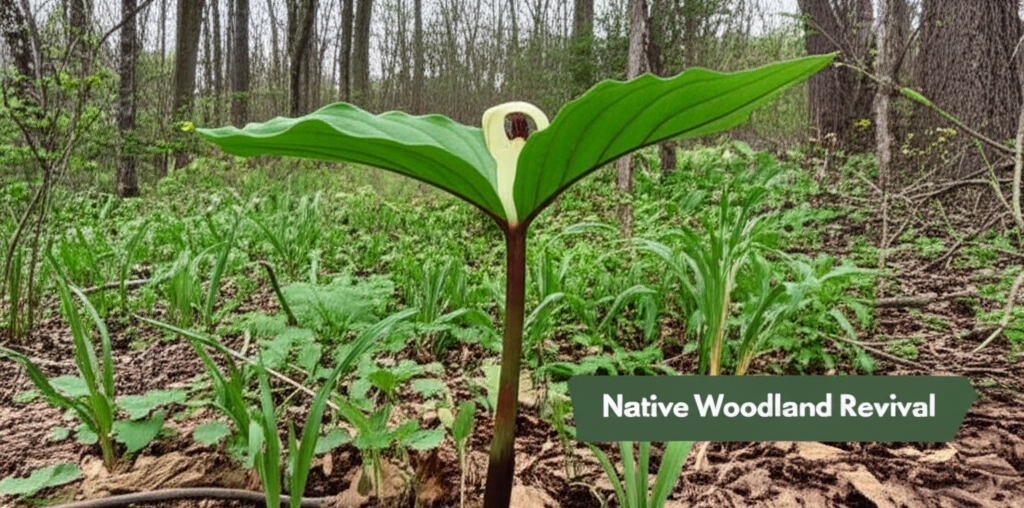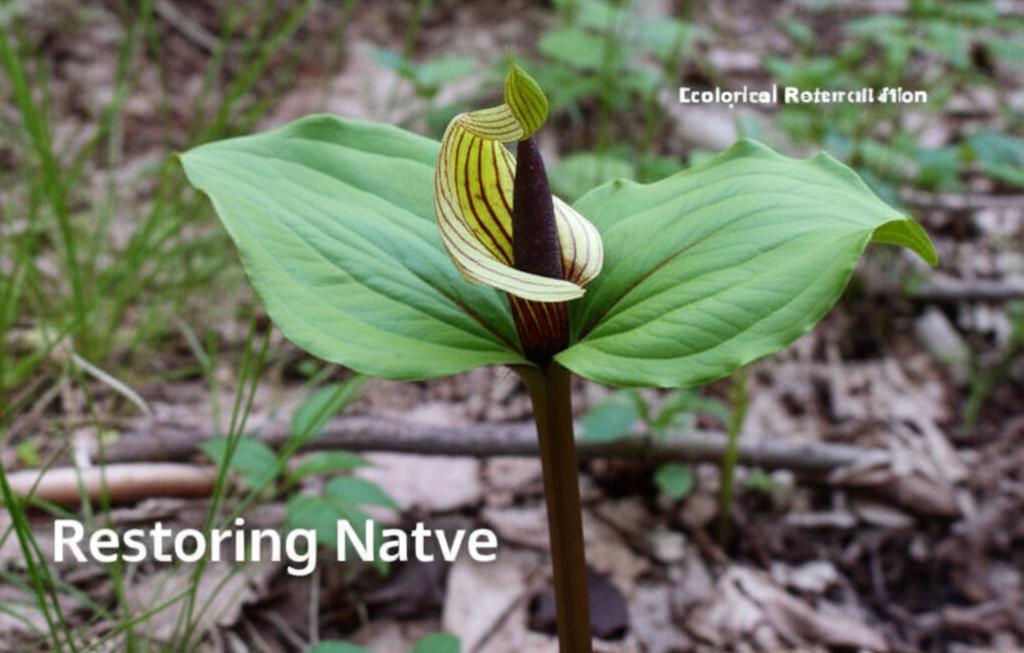Introduction: Unveiling the Charms of the Jack-in-the-Pulpit
The Jack-in-the-Pulpit, scientifically known as Arisaema triphyllum, is a captivating woodland wildflower native to eastern North America. Its distinctive hooded spathe, resembling a preacher in a pulpit, makes it instantly recognizable. Beyond its aesthetic appeal, this fascinating plant plays a surprisingly significant role in the health and resilience of its native ecosystems, making it a valuable asset in ecological restoration projects. This article will delve into the ecological importance of the Jack-in-the-Pulpit, its specific benefits in restoration efforts, and practical considerations for its successful implementation.
A Keystone Plant in Eastern Woodlands
The Jack-in-the-Pulpit is more than just a pretty face; it is an integral part of the complex web of life in deciduous forests. Its ecological niche is multifaceted, contributing to soil health, supporting wildlife, and even influencing plant community dynamics. Understanding these intrinsic ecological roles is crucial for appreciating its potential in restoration.
- Habitat Requirements: This perennial herb thrives in moist, shady environments, typically found in rich, well-drained soils of mature forests, along stream banks, and in wet meadows. Its preference for these specific conditions makes it an indicator species for healthy woodland habitats.
- Reproductive Strategy: The Jack-in-the-Pulpit exhibits a unique reproductive strategy. It is a cormous perennial, meaning it grows from a solid underground stem called a corm. Its flowers are borne on a spadix, enclosed by a spathe. After pollination, the female flowers develop into bright red berries, which are a vital food source for various wildlife.
- Seasonal Presence: Its emergence in spring, followed by its distinctive bloom, and then the development of its berry clusters in late summer and fall, provides resources and visual interest throughout the growing season.
Ecological Significance and Benefits
The contributions of the Jack-in-the-Pulpit to its ecosystem are substantial, impacting both the abiotic and biotic components of the environment.
- Soil Health: The plant’s extensive root system helps to bind soil, preventing erosion, particularly on sloped forest floors and along waterways. As the plant decomposes, it adds organic matter to the soil, enriching its structure and fertility.
- Habitat and Food Source for Wildlife: The bright red berries are a crucial food source for a variety of birds, including thrushes, robins, and woodpeckers, as well as small mammals like chipmunks and squirrels. The dense foliage also provides shelter and nesting opportunities for insects and small amphibians.
- Pollinator Attraction: While not a primary nectar source, the unique structure of the Jack-in-the-Pulpit’s flower attracts various insects, including flies and gnats, which act as pollinators. This interaction contributes to the biodiversity of the local insect population.
- Indicator Species: Its presence and abundance can serve as an indicator of the health and integrity of a woodland ecosystem. A decline in Jack-in-the-Pulpit populations can signal underlying environmental stressors such as habitat degradation, invasive species, or changes in soil moisture.
Jack-in-the-Pulpit in Ecological Restoration Projects

The inherent ecological value of the Jack-in-the-Pulpit makes it a prime candidate for inclusion in a wide array of ecological restoration projects. Its ability to stabilize soil, support wildlife, and thrive in specific conditions offers tangible benefits for re-establishing healthy and resilient habitats.
Why Choose Jack-in-the-Pulpit for Restoration?
Restoration efforts often aim to recreate the complex ecological processes of a native habitat. The Jack-in-the-Pulpit contributes to this goal in several key ways.
- Habitat Reconstruction: When restoring degraded woodlands or creating new forest habitat, introducing native understory plants like the Jack-in-the-Pulpit is essential for establishing a complete and functional ecosystem. It helps to mimic the natural composition of a healthy forest floor.
- Erosion Control: In areas prone to erosion, such as cleared slopes or disturbed riverbanks, the Jack-in-the-Pulpit’s fibrous root system can provide effective natural stabilization, reducing soil loss and improving water quality.
- Enhancing Biodiversity: By providing food and shelter for a range of fauna, the plant directly contributes to increasing biodiversity within a restored area. This creates a more robust and self-sustaining ecosystem.
- Building Soil Health: The addition of organic matter through decomposition improves soil structure, water retention, and nutrient availability, creating a more favorable environment for other native plants to establish and thrive.
- Aesthetic and Educational Value: Beyond its ecological function, the striking appearance of the Jack-in-the-Pulpit can enhance the aesthetic appeal of a restored site, making it more engaging for public appreciation and educational purposes.
Key Facts and Comparison with Other Restoration Plants
To understand the specific advantages of using Jack-in-the-Pulpit, it’s helpful to compare it with other common native plants used in restoration.
| Feature | Jack-in-the-Pulpit (Arisaema triphyllum) | Wild Ginger (Asarum canadense) | Ostrich Fern (Matteuccia struthiopteris) | Blue-stemmed Goldenrod (Solidago caesia) |
|---|---|---|---|---|
| Habitat Preference | Moist, shady woodlands, rich soil | Shady, moist forests, often with leaf litter | Wet to moist, shady areas, stream banks, bottomlands | Shady to partly sunny, moist to dry woods, rocky slopes |
| Primary Restoration Benefit | Soil stabilization, wildlife food (berries), habitat complexity | Ground cover, soil stabilization, shade tolerance | Erosion control, habitat for amphibians, moisture regulation | Pollinator support, wildlife food (seeds), late-season color |
| Root System | Fibrous, good for soil binding | Rhizomatous, spreads horizontally, good for ground cover | Spreading rhizomes, extensive root system | Rhizomatous, fibrous roots |
| Wildlife Value | High (berries for birds/mammals) | Moderate (shelter for small invertebrates) | Moderate (shelter, moisture for amphibians/insects) | High (seeds for birds, nectar for pollinators) |
| Maintenance Needs | Low once established, requires shade | Low once established, tolerant of leaf litter | Low to moderate, thrives in consistent moisture | Low to moderate, adaptable to varying moisture |
Implementation Strategies for Jack-in-the-Pulpit in Restoration
Successfully integrating Jack-in-the-Pulpit into restoration projects requires careful planning and execution, considering its specific needs and the project’s overall goals.
Site Selection and Preparation
The foundation of any successful restoration is selecting the right site and preparing it appropriately for the chosen species.
- Habitat Assessment: Thoroughly assess the site’s soil type, moisture levels, light exposure, and existing vegetation. The Jack-in-the-Pulpit prefers rich, well-drained soils and consistent shade.
- Invasive Species Removal: Before planting, it is crucial to remove any competing invasive plant species that could outcompete the native Jack-in-the-Pulpit.
- Soil Amendment: If the soil is poor, amending it with organic matter, such as compost or leaf mold, can significantly improve its suitability for the Jack-in-the-Pulpit.
- Creating Microhabitats: Consider mimicking natural conditions by incorporating elements like decaying logs or leaf litter, which the Jack-in-the-Pulpit thrives in.
Planting and Establishment Techniques
The method of planting and ongoing care will influence the success of the Jack-in-the-Pulpit’s establishment.
- Sourcing Plants: Obtain seeds or corms from reputable native plant nurseries or collect them ethically and sustainably from areas with healthy populations, ensuring compliance with local regulations.
- Planting Depth and Spacing: Plant corms at a depth of 3-5 inches, with the growing tip facing upwards. Spacing can vary, but typically 6-12 inches apart is recommended to allow for spread.
- Seed Sowing: If using seeds, stratification (exposure to cold, moist conditions) is usually required. Sow seeds in early spring or fall in a prepared seedbed or directly into the restoration site.
- Mulching: Apply a layer of organic mulch, such as shredded leaves or wood chips, around the newly planted Jack-in-the-Pulpit. This helps retain soil moisture, suppress weeds, and regulate soil temperature.
- Watering: During the establishment phase, ensure the plants receive adequate moisture, especially during dry periods. Once established, they are relatively drought-tolerant but prefer consistent moisture.
Monitoring and Long-Term Management
Ongoing observation and adaptive management are key to ensuring the long-term success of Jack-in-the-Pulpit within a restored ecosystem.
- Regular Surveys: Periodically monitor the population size, health, and reproductive success of the Jack-in-the-Pulpit.
- Invasive Species Control: Continue to monitor for and manage any returning invasive plant species.
- Assessing Wildlife Use: Observe and document the use of the Jack-in-the-Pulpit by wildlife, which can serve as a positive indicator of ecosystem health.
- Adaptive Management: Adjust management strategies based on monitoring results. This might involve supplemental planting, further invasive species control, or altering site conditions if necessary.
Challenges and Considerations
While valuable, incorporating Jack-in-the-Pulpit into restoration projects is not without its challenges. Awareness and proactive planning can mitigate these hurdles.
| Stage/Aspect | Steps/Description | Pros | Cons |
|---|---|---|---|
| Planning | Site assessment, goal setting, species selection | Ensures suitability, maximizes impact, cost-effectiveness | Requires ecological expertise, can be time-consuming |
| Sourcing | Purchasing from nurseries, ethical seed collection | High-quality plants, genetic diversity, legal compliance | Can be expensive, availability may vary |
| Planting | Proper depth, spacing, and site preparation | Maximizes survival rates, encourages establishment | Labor-intensive, requires specific knowledge |
| Establishment | Mulching, watering, initial weed control | Reduces stress, promotes growth, minimizes competition | Requires ongoing monitoring, potential for drought stress |
| Long-Term | Monitoring, invasive management, adaptive strategies | Ensures sustainability, ecosystem health, resilience | Requires commitment, can be resource-intensive |
| Ecological Contribution | Soil stabilization, wildlife food/habitat | Improves ecosystem function, enhances biodiversity | Slow to establish, impact may not be immediate |
| Patience Required | Jack-in-the-Pulpit can take several years to establish and flower | The plant is an indicator of a healthy, mature woodland, which takes time to develop. | Results are not immediate, requires long-term commitment from project managers. |
Patience and Realistic Expectations
One of the primary considerations is the time it takes for Jack-in-the-Pulpit to establish and flourish. It is not an “instant gratification” plant.
- Slow Establishment: It can take several years for corms to mature enough to flower and produce berries. Initial efforts may focus on vegetative spread before significant seed production.
- Need for Mature Forest Conditions: The Jack-in-the-Pulpit is an indicator of a healthy, established woodland. Restoration projects aiming for its inclusion should focus on creating or restoring these mature forest characteristics, which inherently take time.
- Long-Term Vision: Restoration is a marathon, not a sprint. Project timelines and funding should reflect the gradual nature of ecological recovery.
Competition and Habitat Disturbance
The success of Jack-in-the-Pulpit can be hindered by external factors.
- Invasive Species: Aggressive invasive plants can quickly outcompete native seedlings and established plants, requiring continuous management.
- Habitat Fragmentation: In fragmented landscapes, it can be challenging for native plants to disperse and establish, and they may be more vulnerable to edge effects and other stressors.
- Human Disturbance: Foot traffic, off-road vehicle use, and other forms of human disturbance can damage delicate understory vegetation.
Variability and Regional Differences
It’s important to acknowledge that Jack-in-the-Pulpit is not a monolithic species, and its performance can vary.
- Subspecies and Varieties: There are different subspecies and varieties of Arisaema triphyllum across its range, which may have slightly different ecological requirements and growth rates.
- Local Provenance: Using plants or seeds sourced from local populations is generally recommended to ensure they are adapted to the specific climate and environmental conditions of the restoration site.
Conclusion: A Small Plant with a Big Impact
The Jack-in-the-Pulpit, with its unique charm and vital ecological roles, is an invaluable component of successful ecological restoration projects in eastern North America. Its ability to stabilize soil, provide crucial food and habitat for wildlife, and contribute to overall ecosystem health makes it a wise choice for those aiming to re-establish vibrant and resilient native landscapes.
By understanding its ecological significance, implementing thoughtful planting and management strategies, and remaining patient through its establishment period, restoration practitioners can harness the full potential of this remarkable wildflower. As we strive to heal and rebuild our natural world, the humble Jack-in-the-Pulpit stands as a testament to the power of native flora in weaving the intricate tapestry of a thriving ecosystem. Its inclusion in restoration efforts is not merely about adding another plant; it’s about fostering a more robust, biodiverse, and self-sustaining future for our woodlands.


